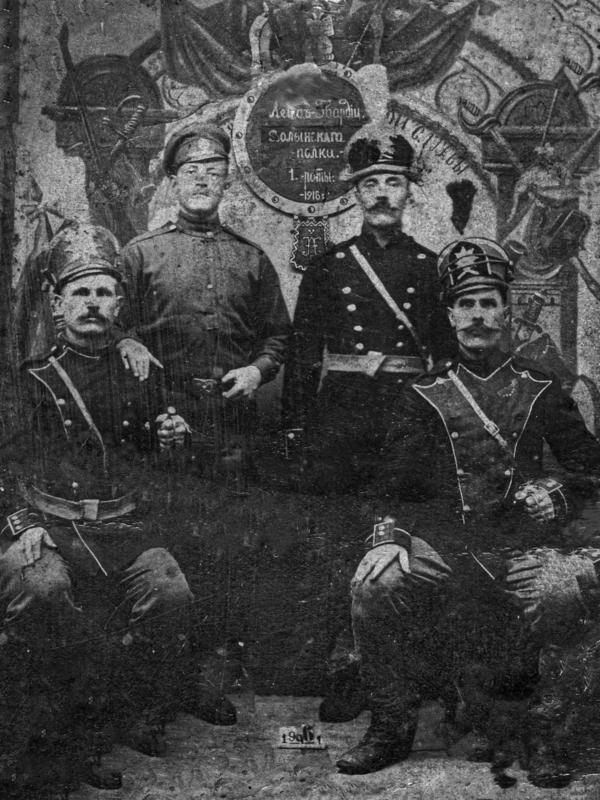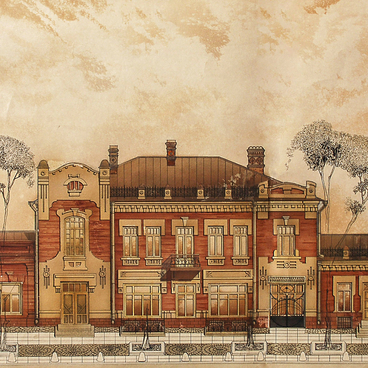Orsk resident, Feodor Dmitrievich Tyagunov served in the Russian Imperial Guard during the First World War. He served as a private in the first division of the Volyn Regiment of the Imperial Guard, considered to be one of the most disciplined and reliable regiments. The regiment fought against German troops. In December 1916, the regiment was withdrawn from the front to Petrograd. It is possible that this is when the photograph was taken. On 27 February 1917, the Volyn regiment was the first to transfer their allegiance to the side of the revolution.
The same morning, the 350-strong regimental drill detachment joined forces with the discontented population in the capital, having already killed their commander, Staff Captain Lashkevich. The riot was lead by one of the battalion’s non-commissioned officer, Timofey Kirpichnikov. Name signs were made in memory of this historical event. In the exhibition, on the left of the photo is a sign that reads: ‘F. Tyagunov - Volyn. 27 February 1917.’
In the photograph itself, the subject standing on the left is a private in the Volyn Regiment of the Imperial Guard, in his field uniform (a cap and battle-grey service shirt). The cap is crumpled, with its edges hanging down over the band, which was a fashionable way to wear the cap at the time. Feodor Dmitrievich Tyagunov is standing on the right in his parade uniform. The background of the photograph is covered in military paraphernalia. The central circle is most likely removable and bears the text: ‘In memory of Military service’. In the very center of the circle the text reads: ‘Imperial Guards Volyn Regiment 1st Division. 1916.’ If you zoom in, it is clear that the word ‘Volyn’ and the number ‘1’ are also removable. The royal cipher of Nicholas II is positioned under the circle, as a reminder that the Emperor was the regiment’s ultimate commander.
Later on, the regiment would be very quick to move over to the sides of the Bolsheviks. During the Kornilov Putsch on 28 and 31 August, the regiment demanded the creation of a unified socialist government and the release of Bolshevik prisoners arrested for the July putsch. On 18 October, the regiment decided to support the armed uprising. During the October Revolution, members of the Volyn Regiment stormed the Winter Palace, patrolled the roads to Smolny and occupied the Finland Railway Station.
Back in Orsk, news of the February Revolution’s victory first came in early March 1917. An emergency session of the Orsk district council was held to discuss the events of 15 March. The meeting’s chairman, N.D. Shein, addressed the attendees with the following words: ‘The old ruling class, for which even the moderate and conservative pockets of the population felt complete contempt has been overthrown, replaced by people in whom the country’s whole confidence rests. Long Live the Provisional Government. Long Live Free Russia.’
The same morning, the 350-strong regimental drill detachment joined forces with the discontented population in the capital, having already killed their commander, Staff Captain Lashkevich. The riot was lead by one of the battalion’s non-commissioned officer, Timofey Kirpichnikov. Name signs were made in memory of this historical event. In the exhibition, on the left of the photo is a sign that reads: ‘F. Tyagunov - Volyn. 27 February 1917.’
In the photograph itself, the subject standing on the left is a private in the Volyn Regiment of the Imperial Guard, in his field uniform (a cap and battle-grey service shirt). The cap is crumpled, with its edges hanging down over the band, which was a fashionable way to wear the cap at the time. Feodor Dmitrievich Tyagunov is standing on the right in his parade uniform. The background of the photograph is covered in military paraphernalia. The central circle is most likely removable and bears the text: ‘In memory of Military service’. In the very center of the circle the text reads: ‘Imperial Guards Volyn Regiment 1st Division. 1916.’ If you zoom in, it is clear that the word ‘Volyn’ and the number ‘1’ are also removable. The royal cipher of Nicholas II is positioned under the circle, as a reminder that the Emperor was the regiment’s ultimate commander.
Later on, the regiment would be very quick to move over to the sides of the Bolsheviks. During the Kornilov Putsch on 28 and 31 August, the regiment demanded the creation of a unified socialist government and the release of Bolshevik prisoners arrested for the July putsch. On 18 October, the regiment decided to support the armed uprising. During the October Revolution, members of the Volyn Regiment stormed the Winter Palace, patrolled the roads to Smolny and occupied the Finland Railway Station.
Back in Orsk, news of the February Revolution’s victory first came in early March 1917. An emergency session of the Orsk district council was held to discuss the events of 15 March. The meeting’s chairman, N.D. Shein, addressed the attendees with the following words: ‘The old ruling class, for which even the moderate and conservative pockets of the population felt complete contempt has been overthrown, replaced by people in whom the country’s whole confidence rests. Long Live the Provisional Government. Long Live Free Russia.’



